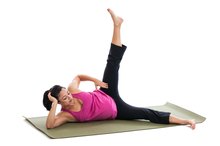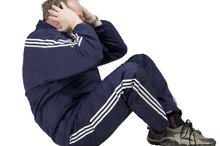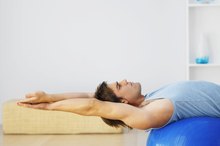Reverse Crunches & Lower Back Pain
While the reverse crunch effectively trains your abdominals, it can be a painful exercise to perform for some individuals. The way the reverse crunch is performed plays a large role in keeping the exercise pain free; however, some people will require modifications to the exercise so that pain does not occur. Learning proper technique as well as the modifications will ensure you perform the reverse crunch safely and will allow you to make a better decision on its inclusion to your abdominal workout program.
Proper Form
Sit on the floor and lean back so that your back and head are flat on the floor. Extend your legs away from your body but keep your butt together. Place your hands under your butt, just below your spine, with your palms flat on the floor. Lift your legs upward while keeping your legs straight by bending at the hips. Once your legs are perpendicular to the floor, lower your legs until your heels are about 1 inch from the floor. Repeat lifting and lowering your legs.
- Sit on the floor and lean back so that your back and head are flat on the floor.
- Once your legs are perpendicular to the floor, lower your legs until your heels are about 1 inch from the floor.
Why It Hurts
Pain During Leg Raises
Learn More
The biggest problem with pain in the lower back from the reverse crunch exercise stems from excess curvature of the spine. Individuals with larger bottoms will have excess torque on their lower back as their legs get closer to the floor. This is due to the hips rotating downward to allow the legs to reach the floor. The other major problem is a lack of flexibility in the lower back or hamstrings. This will cause you to feel a painful stretch in your lower back as your legs reach the perpendicular position. Individuals who already have lower back issues, such as degenerating discs, will also experience pain performing this exercise because the motion causes minor spinal compression as the spine must pivot to help lift the legs.
- The biggest problem with pain in the lower back from the reverse crunch exercise stems from excess curvature of the spine.
- Individuals who already have lower back issues, such as degenerating discs, will also experience pain performing this exercise because the motion causes minor spinal compression as the spine must pivot to help lift the legs.
Modifications
The easiest modification to the reverse crunch exercise is to limit the range of motion you use during the movement. A general rule of thumb is to not lift your legs upward or allow them to descend downward to the point of pain. For instance, if you begin to feel pain when your legs are 2 inches from the floor, only lower them to 1 foot from the floor. You can also bend your knees slightly to reduce the amount of resistance you are moving during the lift.
- The easiest modification to the reverse crunch exercise is to limit the range of motion you use during the movement.
- You can also bend your knees slightly to reduce the amount of resistance you are moving during the lift.
Considerations
Do Sit-Ups Cause Back Pain?
Learn More
If you are experiencing pain when performing reverse crunches, do not ignore it. Failure to address pain during this exercise can lead to further, more serious, back injures and finding a suitable substitute exercise is not difficult.
On the other hand, some individuals may find this exercise too easy and may not experience back pain at all. A common recommendation is to add ankle weights to increase the amount of weight you have to lift during the exercise; however, this increase in weight may trigger lower back pain during the exercise. Start with smaller weights and progress to heavier weights as you test how the lower back feels with using ankle weights.
- If you are experiencing pain when performing reverse crunches, do not ignore it.
- Failure to address pain during this exercise can lead to further, more serious, back injures and finding a suitable substitute exercise is not difficult.
Related Articles
References
- American Council on Exercise: Supine Reverse Crunch
- ExRx.net: Lying Leg-Hip Raise
- Huxel Bliven KC, Anderson BE. Core stability training for injury prevention. Sports Health. 2013;5(6):514–522. doi:10.1177/1941738113481200
- American Council on Exercise. New Study Puts the Crunch on Ineffective Ab Exercises.
Writer Bio
Joshua Bailey has been writing articles since 2006 with work appearing at Bodybuilding.com and 2athletes.com. Bailey holds the following certifications: NASM-CPT, NASM-PES, NASM-CES and NSCA-CSCS. He also holds a Bachelor of Science in exercise and sports science from the University of North Carolina, Chapel Hill and a Master of Science in exercise physiology from the University of North Carolina, Greensboro.








